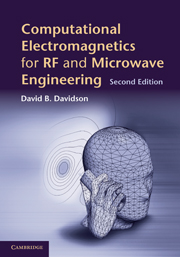Book contents
- Frontmatter
- Dedication
- Contents
- Preface to the second edition
- Preface to the first edition
- Acknowledgements
- To the reader
- List of notation
- 1 An overview of computational electromagnetics for RF and microwave applications
- 2 The finite difference time domain method: a one-dimensional introduction
- 3 The finite difference time domain method in two and three dimensions
- 4 A one-dimensional introduction to the method of moments: modelling thin wires and infinite cylinders
- 5 The application of the FEKO and NEC-2 codes to thin-wire antenna modelling
- 6 The method of moments for surface modelling
- 7 The method of moments and stratified media: theory
- 8 The method of moments and stratified media: practical applications of a commercial code
- 9 A one-dimensional introduction to the finite element method
- 10 The finite element method in two dimensions: scalar and vector elements
- 11 The finite element method in three dimensions
- 12 A selection of more advanced topics in full-wave computational electromagnetics
- Appendix A The Whitney element
- Appendix B The Newmark-β time-stepping algorithm References
- Appendix C On the convergence of the MoM Reference
- Appendix D Useful formulas for simplex coordinates
- Appendix E Web resources
- Appendix F MATLAB files supporting this text
- Index
- References
9 - A one-dimensional introduction to the finite element method
Published online by Cambridge University Press: 05 July 2014
- Frontmatter
- Dedication
- Contents
- Preface to the second edition
- Preface to the first edition
- Acknowledgements
- To the reader
- List of notation
- 1 An overview of computational electromagnetics for RF and microwave applications
- 2 The finite difference time domain method: a one-dimensional introduction
- 3 The finite difference time domain method in two and three dimensions
- 4 A one-dimensional introduction to the method of moments: modelling thin wires and infinite cylinders
- 5 The application of the FEKO and NEC-2 codes to thin-wire antenna modelling
- 6 The method of moments for surface modelling
- 7 The method of moments and stratified media: theory
- 8 The method of moments and stratified media: practical applications of a commercial code
- 9 A one-dimensional introduction to the finite element method
- 10 The finite element method in two dimensions: scalar and vector elements
- 11 The finite element method in three dimensions
- 12 A selection of more advanced topics in full-wave computational electromagnetics
- Appendix A The Whitney element
- Appendix B The Newmark-β time-stepping algorithm References
- Appendix C On the convergence of the MoM Reference
- Appendix D Useful formulas for simplex coordinates
- Appendix E Web resources
- Appendix F MATLAB files supporting this text
- Index
- References
Summary
Introduction
The finite element method (FEM) is one of the best-known methods for the solution of partial differential equations in applied mathematics and computational mechanics. It is a method for solving a differential equation subject to certain boundary values, and in its modern form originated in the field of structural mechanics during the late 1950s; the first specific usage of the term “element” is due to no lesser a person than Courant. In common with the MoM, its historical antecedents are far older than this, in this case dating back to the nineteenth century and the variational methods first described by Lord Rayleigh. It is very widely and routinely used in structural mechanics today, as well as in computational fluid dynamics, computational thermodynamics, the numerical solution of Schrödinger's equation, field problems in general, and of course, in electromagnetics.
An historical aside — Courant and the finite element method
The finite element method as presently accepted can be credited to Courant — whom we have already encountered in the context of the Courant limit for the FDTD method. The published version of his 1942 address to the American Mathematical Society contained an appendix added after the talk, to show by example how variational methods could be put to wider use in potential theory. He used piecewise linear approximations, on a set of triangles which he called “elements” — and thus the method was born [1, p. 5].
- Type
- Chapter
- Information
- Computational Electromagnetics for RF and Microwave Engineering , pp. 317 - 341Publisher: Cambridge University PressPrint publication year: 2010



